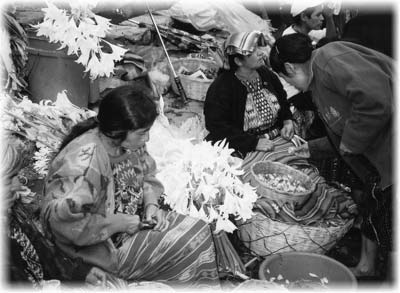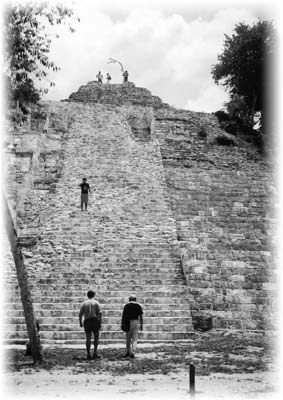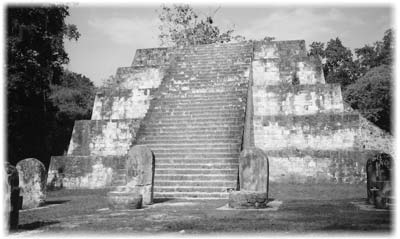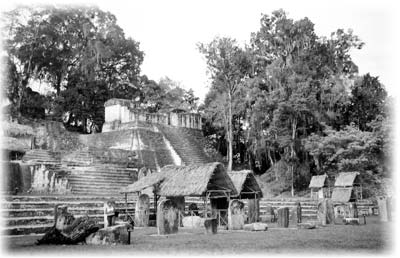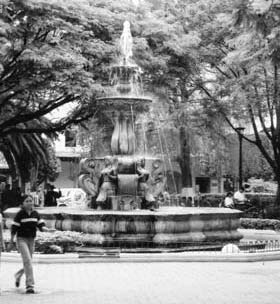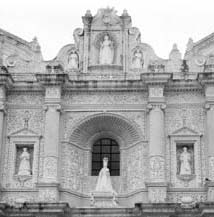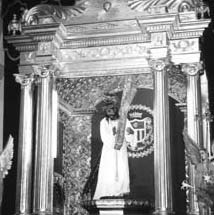Guatemala — exploring the land of the Maya
—Story and photos by Judith Anshin, Contributing Editor
Guatemala, after suffering years of civil war, is now beckoning. Peace accords were signed with the guerrillas in 1996, and they have held to today. In the hope of attracting more high-end travelers, new hotels have been built in the Flores/Tikal area, the airport is being upgraded, and Continental Airlines inaugurated two direct flights a week from Houston to Flores/Tikal.
To familiarize travelers with the “new” Guatemala, INGUAT (Instituto Guatemalteco de Turismo), the tourism agency for the country, invited travel writers and tour operators from around the world to encounter the Mayan world. Having long wanted to visit, I leaped at the chance.
Lake Petén Itzá
Guatemala is divided into departments, and the El Petén department is home to many Mayan ruins, including Tikal, the most famous. The town of Flores, the departmental capital, is built on an island in Lago Petén Itzá. Santa Elena, one of the towns along the lake, was the site of the conference and featured some new hotels.
My hotel, La Casona del Lago (phone 502 7952 8700 or visit www.hotelesdepeten.com), was only two months old at the time of my May ’05 visit and featured a beautiful pool and Jacuzzi plus views of the lake and Flores. (Room rates start at $50 single and $75 double.)
Lake Petén Itzá is a freshwater lake with 16 islands, not to mention crocodiles and numerous species of fish. A mid-morning excursion on the lake took us to a reserve, where a network of trails led to many animals — monkeys, crocodiles, a jaguar and warthogs that wandered carelessly among us — and innumerable beautifully colored birds.
I’m very sensitive to the conditions of caged animals, but most of the animals I saw were in roomy enclosures. Only those that could be dangerous to humans were actually caged.
The walk and boat trip were excellent introductions to Guatemala, even after a red-eye flight from the U.S.!
Educational speakers
Dr. Arthur A. Demarest, who has worked in Guatemala for more than 20 years, was a mesmerizing speaker and really made the Mayan world come alive.
According to Dr. Demarest, the civil war of the past helped to preserve ruins for archaeologists because it kept the number of visitors down. But now, tourism is vital to archaeology in Guatemala, which has more ruins than Mexico and is in need of a large museum. If tourism, conservation and archaeological efforts work together, sites can be protected for future generations to enjoy.
Another speaker, Dr. Richard Hanson, also an American archaeologist, has worked predominately in the Mirador Basin in northern Guatemala, just a few miles from the Mexican border.
The Danta Pyramid located there is believed to be the largest in the world! Unfortunately, we did not get to visit the site, but much of the work there has been done with the financial support of National Geographic, which has profiled the work in their magazine.
Guidebooks give little information on the site because it is currently difficult to reach, requiring strenuous jungle hiking over several days with no amenities available en route.
Tikal
Archaeology is important not just to Guatemala’s tourism industry but to the ecology of the country. Tikal National Park has saved 576 square kilometers of forest, with 2,200 square kilometers remaining to be added after excavation and restoration of the remaining ruins. The Guatemalan government is working on a plan to control access to ancient sites so as not to damage the region or the sites.
The first report of the ruins at Tikal was in 1848, but it wasn’t until 1955 that Tikal National Park was created. In 1979 it was declared a UNESCO World Heritage Site. In the entire park, it is estimated there are between 8,000 and 11,000 structures — temples, palaces, squares, monumental tombs and long roads — with 3,400 of them covering just 16 square kilometers. Only 18% have been unearthed and reconstructed.
The Mayans covered their buildings with stucco, and as the jungle and rainforest grew over the structures, the stucco protected them. As these structures are unearthed, archaeologists are finding that the stucco is crumbling and erosion has begun to set in, so many reconstructed sites are being restuccoed to protect them.
The excursion to Tikal was the fulfillment of a long-held dream for me. I had seen many pictures and read extensively about the site, but seeing it in person was exciting.
Even with good, mild weather, the hike around the site was difficult. The loop from the entrance and back is six miles of difficult walking. While there are trails, the surface is uneven with many rocks and tree roots and, occasionally, very steep but short grades, as Tikal was built on a hill in the jungle.
Along the trails are ruins still covered by the jungle. In most cases, the shapes of the jungle growth gave a hint of the underlying structures.
Notable ruins
Tikal’s Great Plaza is the area that is most photographed. Twin pyramids, actually temples, anchor the east and west ends of the Great Plaza. Named Temple I and Temple II, each pyramid was once topped with a small enclosure with three rooms and an arch at the very top. Temple II no longer has the full arch.
Extremely steep steps lead to the tops, affording spectacular views. However, several people have died after falling off the steps, so great care and caution are required.
Along the north edge of the Great Plaza stands the North Acropolis. In excavating and reconstructing this acropolis, archaeologists have discovered more than a dozen layers of construction. Still standing at one edge of the acropolis are two rows of stelae on which were recorded the various accomplishments of the rulers of Tikal.
The Central Acropolis, the South Acropolis, the West Plaza, the Plaza of the Seven Temples, Temples IV and VI and Complexes N and P are just some of the excavated and reconstructed ruins within the Tikal National Park. One could easily spend several days exploring.
Yaxhá
The next day I joined an excursion to Yaxhá, which dates from 200 B.C. It is being excavated and restored by a group of German archaeologists working with the Guatemalans.
It is estimated that 60,000 people lived within its 50 square kilometers. Within the area, 382 species of birds, five species of cats, three species of monkeys and 120 species of snakes can be found.
While most of the trails here are slightly better than at Tikal, with wooden staircases covering the more difficult grades, there are still some treacherous areas. There are also twin pyramids here, as well as a grand plaza, ball courts, acropolises and temples. Driving in on an unpaved road, we had a view of the top of one pyramid sticking out of the jungle — an awesome sight.
Following the conference, I had arranged to stay another week in Guatemala so I could explore Antigua, Chichicastenango and the Lake Atitlán area. Miguel Gonzalez, who owns Voyageur Tours in Antigua (phone 502 7832 4237 or visit www. cometoguatemala.com), offered to host me on my travels around this area. Miguel lived and worked in San Francisco, California, for three years, so his English is unaccented and he understands what interests American travelers. I was extremely pleased with the travel he arranged for me and can recommend him without reservation.
He also helped me purchase a print by a famous Atitlán artist and get it framed for a fraction of the cost I would have paid at home.
Antigua
Built in the Spanish Colonial style, Antigua was named a UNESCO World Heritage Site in 1979. It retains the cobbled streets and many of its old colonial buildings.
Volcanoes ring the city, so on a clear day they can be used for directional guides.
In the center of town is the main square, Parque Central, with the Catedral de Santiago on the east side and the town hall, housing the Museo de Santiago, on the north. The park is an interesting place to sit and watch the world go by. Many villagers sell items here to the tourists, but they are not pushy at all. A smile and a polite “No” suffice.
Of the many ruins and churches in Antigua, my favorites were Las Capuchinas, a former convent, and Santo Domingo Convent, now the site of the luxury Hotel Casa Santo Domingo. The convent/hotel covers a full block, and the ruins have been lovingly preserved and worked into the grounds of the hotel. It is a favorite spot for weddings for brides from all over Guatemala, and during Semana Santa, Holy Week, rooms are booked far in advance.
Very nice museums have also been incorporated into the convent ruins, and the Pre-Columbian Art &Modern Glass Museum is beautifully laid out.
I stayed in Antigua for two nights at Hotel Aurora (4a Calle Oriente No. 16), which is decorated in the colonial style with a lovely courtyard. A single room with bath costs $48 including taxes and Continental breakfast. During an afternoon of showers, I sat comfortably on the covered loggia reading and enjoying the many beautiful flowers. Wandering the city was fun, and I could happily have spent several more days there.
Chichi
The famous Chichicastenango market is held on Thursdays and Sundays, so Thursday morning I was picked up at my hotel by a shuttle coach driver for the long drive there. The roads were quite good, but at several curves the gradient had to be more than 30%. A stop for breakfast about midway was a welcome break.
Upon arriving at “Chichi,” I was met by Humberto, the guide Miguel had arranged for me.
The Iglesia de Santo Tomás is the center of Chichi life. Visitors enter the church via the side door, and the interior, while simple, is interesting. Offerings of corn, flowers and candles are everywhere, and the interior is quite blackened from the great numbers of candles burned over the years. Although it’s a Catholic church, many of the rituals performed here have a Mayan background.
The market spreads out from the steps of the church in every direction and features handicrafts brought to Chichi by villagers from all over the region. Bargaining is the rule, of course.
I saw so many lovely things, especially the clothes, bags and weavings. The handicrafts throughout Guatemala are of very good quality and are extremely colorful.
Note: Mayan women do not wish to be photographed, and even paintings of them often show them from the back.
Panajachel
After a nice lunch at Hotel Santo Tomás, it was time to leave for Lake Atitlán. Along the shores of the lake is Panajachel, a traditional town, where I chose to stay.
My room at Hotel Dos Mundos (Calle Santander 4-72; fax 502 7762 0127 or visit hoteldosmundos.com) was quite nice and overlooked the swimming pool and gardens. It was too chilly to swim, but it was wonderful to sit on the covered porch and read. My single room cost $50 including taxes and breakfast.
Pana, as the town is called, is pretty touristy, and many hippies remain from its heyday before the war. Nonetheless, I enjoyed wandering the streets.
The main street down to the lake was lined with vendors selling everything imaginable from very colorful displays. The colors in Guatemala were exceptionally vibrant and alive, and stalls of wooden masks or woven cloths were a visual feast. A wide variety of food, including Indian and vegetarian, was available at Pana’s many restaurants — another link to the “hippie days.”
On Saturday morning I again met Humberto, and we spent a day on the lake visiting three of the 12 surrounding villages.
Lake Atitlán covers 130 square kilometers, with an average depth of 300 meters. Three volcanoes surround the lake: Volcan San Pedro, Volcan Toliman and Volcan Atitlán.
Ethnic villages
There are 21 Mayan languages still spoken in Guatemala. In the villages I visited, each ethnic group spoke a different language and wore different styles of clothing.
The first village I visited, San Pedro La Laguna, is reputed to grow the best coffee in the area, thanks to the volcanic soil. The second village, Santiago Atitlán, is the largest on the lake, with 35,000 people. The Tzutujil Mayas there have the most beautiful, colorful woven blouses, or huipiles, featuring birds and flowers. The pieces seem expensive, but when one considers the many, many hours of work involved, they are quite reasonable. Unfortunately, I couldn’t think of an occasion when I could wear one back home, and Humberto said many American and British tourists say the same thing.
There were many art galleries here, too, and I enjoyed visiting them.
The third village, San Antonio Palopo, also offered interesting weavings, though they were less flamboyant than those in Santiago Atitlán. There is a weaving cooperative here with set prices that exports goods all over the world. Members can also sell directly to visitors, and many of the women from the boat were buying beautiful scarves.
Friendly gesture
Throughout my visit, I felt very safe and secure and found the Guatemalan people extremely warm and friendly. An incident at the airport the morning I was leaving really cemented my feelings for the people and the country.
My framed print from Antigua was too large to fit into my carry-on, so I checked my bag and carried the picture under my arm. I used my inflatable back pillow and a sweater to somewhat protect the glass.
While wandering through the many stores in the airport, somewhere along the way I dropped the pillow. Although I could replace it at home, it cost around $30, so I went to the information desk and asked if there was a way to announce within the terminal the loss of my pillow. They did so, and within a couple of minutes a gentleman came walking up with it! I’ve traveled in countless countries where that pillow would have been gone forever, but not so in Guatemala!
As my plane took off, I felt a twinge of sadness to be leaving a place where I had had such a wonderful time.


